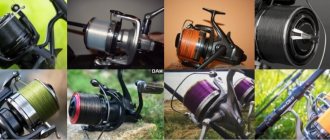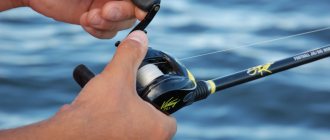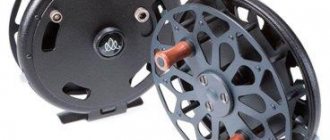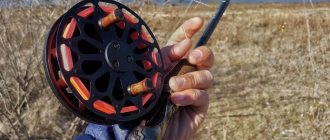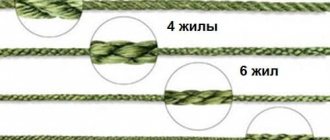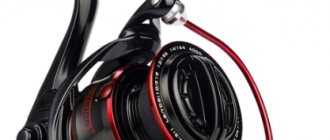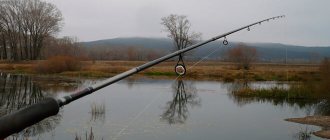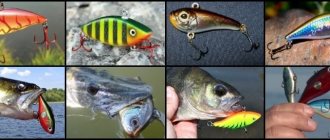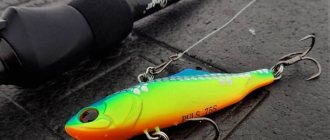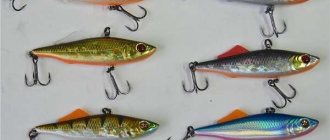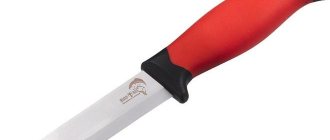| Place | Name | Characteristics in the rating |
| TOP 5 best Daiwa reels |
| 1 | DAIWA Ninja LT 3000-C | The most reliable clutch |
| 2 | DAIWA Exceler 3000D-C LT (17) | The best characteristics for spinning fishing |
| 3 | DAIWA Sweepfire E 2000C | The most popular reel. Best price |
| 4 | DAIWA Black Widow BR 4000A | A practical choice for trophy fishing. Good value for money |
| 5 | DAIWA Tatula SV TW 103XSL | The best choice for sea fishing |
Japanese spinning reels are distinguished by high quality workmanship, regardless of the price segment in which the models are presented. This allows you to choose fishing equipment with optimal characteristics in any price range.
The review presents, in our opinion, the best models of Daiwa fishing reels. When compiling the rating, information from reviews of owners with practical experience in using these fishing reels in various conditions was taken into account.
Reel in feeder gear
Inertialess reels are installed on feeder rods. Multiplier coils for the feeder are not considered as they do not provide the necessary functions. With a multiplier it is impossible to throw large weights over long distances; the reeling speed is low. There is no clip, which makes it impossible to set the working range of the equipment.
Feeder reels are suitable for both special ones, created specifically for this method of fishing, and universal spinning, match, carp or trolling reels. The main thing is that the assembled tackle provides the necessary functionality. Feeder tactics are characterized by sufficient fishing intensity; frequent recasts over long distances with high accuracy are required. Naturally, the inertia-free system must withstand all these loads. Features of the process create technical requirements for reels for feeder fishing.
The choice of a reel for feeder fishing is not made based on external beauty. Only the sum of the characteristics allows you to achieve the functionality of the feeder gear and ensure the correct operation of the equipment. Let's take a closer look at what type of spinning reel is required for the feeder.
Winding quality
All other things being equal, you need to choose reels with even laying of the cord or line on the spool. Proper placement affects casting distance. During casting, self-resetting of the loops is not allowed, and when reeling in, overflowing through the front surface of the spool is not allowed. Branded models usually always have high-quality winding. There are many good models with high-quality styling and among inexpensive representatives. You can find out this when purchasing in a store by asking the seller to reel in the fishing line. When purchasing from online stores, you should study reviews on the Internet in detail before making your final choice.
Size and spool
The feeder is not an ultralight spinning rod; you need large spools and powerful engines. The most popular reels for feeder fishing are with a spool size of 4000 (according to Shimano classification). The moment of choosing the size is directly related to the caliber of the tackle for which the inertia-free gear is selected.
Feeder reels for long-distance casting should be able to wind 150 meters of thin braid, from 0.08 to 0.12 mm in diameter. Therefore, very small match spools are not suitable. Such casting distances are typical for Heavy feeders. Therefore, another condition is added to the ability to accommodate the required volume of cord - the power of the mechanism. A reel for a heavy feeder should easily reel in large weights of feeders from long distances. Therefore, small sizes (at least 2000) in the feeder are only applicable for the picker.
Large sizes, 4000 and above, make it comfortable to work with feeders of 80 grams and above. This size is a universal medium, for working with medium and heavy feeder, at distances up to 80 meters. On an Extra Heavy rod, it is better to use a powerful spinning rod, 5000 or 6000. The four may not be able to handle it. Here the question of the quality of the meat grinder is already important. Good devices, for example, Shimano four-thousanders, cope with 100-gram feed at a distance of 80 meters. Budget options of the same size may no longer hold up. For extra-heavy ones, it’s better to immediately set at least size 5000. The issue of safety of the mechanism is simply important here. The greater the load on it, the faster the mechanics will break due to wear. Read more about the classification - rods for feeder fishing.
Spool size and backing
Match reels on the feeder are placed on pickers and lights. For this, large representatives of the matcha are suitable - 3000 or 4000. Even on a picker, sometimes you have to install heavy feeders and catch carp or carp. The minimum limit is size 2000. Suitable for light pickers, close range and small fish.
Standard spinning baits for bottom fishing are usually equipped with a deep spool. To fill it with thin, expensive braid, you will need hundreds of meters of cord. Therefore, winding more than 150 meters of working cord is impractical. It’s easier to wind backing made of cheap braid, and a working cord on top of it. Read more about winding backing.
Some models come with additional match spools on which you can wind the cord without backing. However, this is a small problem; you should not give up a good reel with a deep spool in favor of a bad one, but with a match spool. What is more important is the overall reliability of the mechanism. And I wound the backing once and forgot about it.
Model selection
Many models of special feeder reels for long-distance casting have appeared. Such mechanisms are immediately equipped with a small spool for thin braid. Such spinning spools are also produced in large sizes - up to 6000. The spool on them is large, but shallow in depth. However, among the manufacturers that have proven themselves over the years, there are no such ones (for example, Shimano). The largest range of specialized feeder reels is represented by the Flagman brand. In principle, these are good meat grinders, but Shimano or Daiwa have no competitors in terms of reliability. Good budget feeder reels last more than one season - for example, the legendary Ryobi Ecusima. Unless, of course, you use them to hammer nails or force them with overload.
Inertia-free spools with a shallow spool are convenient, and they also come with the usual deep graphite replacement. We wrap the monofilament around the graphite and the cord around the match. On extra-heavy gear for catching trophy carp, carp or catfish, you can use heavy and high-torque carp lures. With this kind of fishing, frequent recasts are not required, and such a combine will help you pull out a trophy. The choice depends on the angler and the gear he is collecting, as well as on whether the spool is selected for braid or fishing line. Read more about the features of feeder equipment.
Dependence of reel size on fishing conditions:
- Distance up to 40 meters, light weights, rods up to 3 meters – size 3000.
- Medium feeder (3-3.6 m), up to 80 grams – 4000.
- Rods over 3.6 meters, distances over 60 meters, feeders heavier than 60 grams - size 4000-6000.
For monofilament you need a deep spool, for thin braid - large and shallow in depth, or standard, followed by backing.
For ease of handling the tackle, the weight of the reel is important. The standard ideal for 4000 is 300-350 grams. For picker it’s lighter, about 250 grams. For extra heavyweights – 400 g and above. Carp power spinners weigh from 500 grams and above.
Clip
An important part of feeder fishing is clipping. When choosing, pay attention to the clip. The best option is a round metal clip. However, more often the spools are equipped with a regular plastic triangular one. The clip on the feeder reel can damage the braid during power casting or break itself. Feeder clipping is a separate topic for discussion. The described inconveniences can be treated simply - by clipping with an elastic band. And when measuring the bottom, when frequent re-clips are needed, the fishing line is clamped in the clip itself through a gasket made from a piece of feedergam. Initially, the plastic clip is not intended for casting - only for transportation. Therefore, if a clip breaks, downloading something from the manufacturer or seller under warranty will not work. Sometimes this is indicated in the instructions (though in Chinese). Read more about clipping when fishing with a feeder.
The clip is an important point, but when choosing a fishing reel for a feeder it is secondary. We still clip it through an elastic band. More important is the quality of the mechanism, compliance with dimensions and gear ratio.
Round clip
Gear ratio
The correct coil ratio for the feeder is 4.8:1 to 5.2:1. This indicator determines how many revolutions the spool makes per turn of the reel handle. When fishing at a tempo pace, it is normal to work with a gear ratio of up to 5.8. However, the higher ones are already high-speed models for spinning, which are inconvenient in the feeder. The feeder needs power coils, not high-speed ones - for comfortable pumping of a heavy feeder from afar. Some anglers prefer an even lower reduction ratio - up to 4.3:1. Athletes choose faster gears to gain time. For amateurs, a gear ratio of up to 5.3 is recommended - why force the tackle and make fishing uncomfortable for yourself. The lower the gearing, the greater the traction and the easier it is to reel in heavy feeders. Therefore, it is recommended to use power coils for an endless screw feeder. Infinity is simply more reliable and durable, especially in budget models, when working with heavy feeders.
Friction clutch
The clutch for the feeder reel needs to be long and easy to set up. Working with the clutch is important - without it it is impossible to bring out large fish on a thin leash, especially when using a cord. The clutch can be front or rear. Which one to choose is up to the fisherman to decide depending on his habits. You need to adjust the ratchet brake depending on the casting distance and the weight of the feeder. It is necessary to achieve a position in which during casting the line does not slip under the finger holding it. The ratchet should not be fully tightened so that it remains possible to dampen the jerks of the fish when hooking. During hooking, the hand is placed on the spool so that the brake does not slip.
Front clutch
Some inertia-free wheels are equipped with a rear clutch with a flag (Fightin Drag). The flag is convenient, especially for power casts. By simply switching the flag, the clutch is completely turned on or off, maintaining the setting. When catching large fish, you can generally set the tackle to free winding. A sort of endless baitrunner.
A feeder reel with a baitrunner is useful when fishing for carp with flat inline or other sliding rigs. The fish calmly takes the bait and reels in a certain amount of line. Then the baitrunner slams shut, the reeling is paused and the fish hooks itself. This function gives the angler time to run to the tackle in case of a bite. The baitrunner is convenient when installing gear for a long time. For tempo fishing, it is easier to use a simple front drag.
Rear clutch with flag
Bearings
The bearings themselves, their number - the moment is far from absolute. A high-quality professional reel with 4 bearings is still better than an underground Chinese one with 12. For the feeder, it is important that there is a bearing in the line roller. If this unit is made poorly and the roller stops as a result of operation, the braid saws through it and damages it. On a feeder reel it is more about the overall quality of the build rather than the number of bearings.
Handle threaded connection
With intensive use of the feeder, almost all budget inertia-free machines exhibit one disease - play in the place where the handle is folded or connected. The strongest handles are those that are screwed into the base with a thread. Such power handles are usually installed on expensive models. You can equip a budget inertia-free machine with such a handle separately - the main thing is that the seat pin and screw fit in diameter and length. We have looked at the general requirements for which coils to put on the feeder. Next, we will analyze popular models of inertialess baits suitable for feeder fishing.
The best models of spinning reels
Check out the models and prices of the best spinning reels from Shimano, Daiwa, and Ryobi.
The best Shimano spinning reels. The model range is distinguished by great variety and price range.
- Shimano Exage is a popular entry-class reel, low cost for decent quality;
- Shimano Catana is also a cheap branded model that will cost you less than $50 from Shimano;
- Shimano Twin Power - a high-quality reel costing from 12,000 rubles;
- Shimano Ultegra - multi-size model, spool size from 1000 to 6000; Average price: 5000 rubles;
- Shimano Nexave is an entry-level model costing less than 2,000 rubles;
- Shimano Biomaster is a middle-class reel with a price of 7,000 rubles;
- Shimano Nasci is an entry level reel. Price 3800 rubles.
Daiwa spinning reels. The most popular models are highlighted in bold, but all of the listed models deserve attention and are of high quality.
- Daiwa Regal is an entry-level spinning reel costing 1,500 rubles;
- Daiwa Exceler is a multi-size reel that has proven its quality over time;
- Daiwa Crossfire is an entry-level reel costing up to 1,900 rubles;
- Daiwa Certate is a high-quality reel that costs from 17,000 rubles.
Rating of the best-selling spinning reels and other fishing products at low prices! Readers have already joined in shopping from China on Aliexpress. Join us too.
Ryoby spinning reels are less well known than the previous two brands, but have nevertheless proven their worth in the hands of a large number of anglers. Here is a rating of the best Ryobi spinning reels.
Ryobi Excia is the most popular budget reel of this company, and the more classy Zauber and Ecusima are breathing in its back. The prices of the second and third reels are much more favorable than other reels of comparable quality and configuration from competing companies.
The best spinning rod for jig, what is it? Tips for choosing a fishing rod on the page of our website.
The best ultralight spinning rods - the editor's choice in the next article.
Spinning rods for twitching - analysis of the main parameters and editorial advice on choosing.
